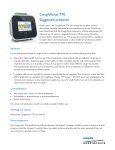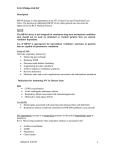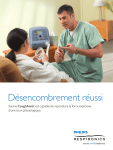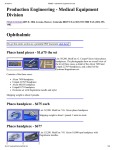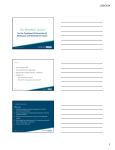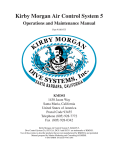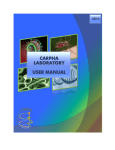Download Emerson CA-3000, CA-3200, CM-3000, CM-3200 User guide
Transcript
CoughAssist ® User Guide Table of Contents Introduction.................................................................................................................................................. 3 Warnings & Cautions................................................................................................................................. 4 Controls, Connectors, Visual Indicators............................................................................................... 6 Accessories..................................................................................................................................................10 Operating Procedure...............................................................................................................................11 Daily Use.......................................................................................................................................................12 Preventive Maintenance .......................................................................................................................16 Cleaning.......................................................................................................................................................17 Troubleshooting Guide...........................................................................................................................18 Specifications.............................................................................................................................................19 EMC Information.......................................................................................................................................21 Limited Warranty.......................................................................................................................................23 CoughAssist User Guide 1 Symbol Key The following symbols appear on this device. Follow Instructions for Use Canadian/US Certification Fuse AC Power Type BF Applied Part | Power On O Power Off Full Inhalation Flow Setting Reduced Inhalation Flow Setting Located next to the terminal inside the unit to identify the protective earth connection. Caution: U.S. Federal law restricts this device to sale by or on the order of a physician. © 2008 Respironics, Inc. and its affiliates. All rights reserved. Respironics and CoughAssist are registered trademarks of Respironics, Inc., and its affiliates. 2 CoughAssist User Guide Introduction Intended Use For use on any patient unable to cough or clear secretions effectively due to reduced peak cough expiratory flow, resulting from high spinal cord injuries, neuromuscular deficits or severe fatigue associated with intrinsic lung disease. It may be used either with a face mask or mouthpiece, or with an adapter to a patient’s endotracheal or tracheostomy tube. Clinical Settings: For use in a hospital/institutional environment, or in the home, given adequate training and a physician’s prescription. Patient Population: For use on adult or pediatric patients. Summary This CoughAssist® Mechanical In-Exsufflator (MI-E) uses a technique referred to as “mechanical insufflation-exsufflation.” • The automatic CoughAssist MI-E (Models CA-3000 and CA-3200) has timing mechanisms to automate the inspiratory and expiratory cycles as well as a manual control. • The manual CoughAssist MI-E (Models CM-3000 and CM-3200) uses a manually operated valve to shift from positive to negative pressure and back. Those who might benefit from the use of the CoughAssist MI-E include any patient with an ineffective cough due to muscular dystrophy, myasthenia gravis, poliomyelitis, or other neurologic disorder with some paralysis of the respiratory muscles, such as spinal cord injury. It may also be used to treat ineffective cough due to other bronchopulmonary diseases, such as emphysema, cystic fibrosis and bronchiectasis. It is effective for both trached and noninvasively ventilated patients. Contraindications Any patient with a history of bullous emphysema, known susceptibility to pneumothorax or pnuemo-mediastinum, or known to have had any recent barotrauma, should be carefully considered before use. CoughAssist User Guide 3 Warnings & Cautions Caution: U.S. Federal law restricts this device to sale by or on the order of a physician. Warnings A warning indicates the possibility for injury to the user or the operator. • Always check time and pressure settings before each treatment. • Always use a new filter when using the device on a new patient. • Patients known to have cardiac instability should be monitored for pulse and oxygen saturation very closely. • Soreness and/or pain in the chest from a pulled muscle may occur in patients using the CoughAssist MI-E for the first time if the positive pressure used exceeds pressures, which the patient normally receives during Positive Pressure Therapy. Such patients should start at a lower positive pressure during treatment, and gradually (over several days, or as tolerated) increase the positive pressure used. [Positive Pressure Therapy includes the use of a volume ventilator, nasal or mask ventilation or CPAP (Continuous Positive Airway Pressure), or IPPB (Intermittent Positive Pressure Breathing).] • Do not use in the presence of flammable anesthetics. • AC power connection should be made to a properly grounded AC outlet only. • Do not place or store the device where it can fall or be pulled into a tub or sink. • If the device comes into contact with water, unplug the unit. • Never operate the CoughAssist MI-E if it has a damaged cord or plug, is not working properly, or has been dropped, damaged or immersed in water. • Replace fuses only with ones having the same ratings for blow characteristics, current and voltage. • Do not remove the cover; there are no serviceable parts inside the unit. Refer all service to authorized personnel. • Use only power cords supplied by Respironics for this device. Use of power cords not supplied by Respironics may cause overheating or damage to the device. 4 CoughAssist User Guide Cautions A caution indicates the possibility of damage to the device. • Position the CoughAssist MI-E so that the air intake ports on the side and rear of the unit are not blocked. • Never operate the device unless a bacterial/viral filter is attached to the patient circuit. • This device is designed for Intermittent Operation Only and not for continuous use. The device should not be cycled continuously for more than 5 minutes. After such time, the unit should either be turned off or left idling with the blower on for at least 5 minutes. • Turn the unit off when not in use. • Keep the power cord away from heated surfaces. • Do not sterilize with ethylene oxide gas or steam sterilize the pump or pump housing. • This device should only be used by trained personnel. • Use only power cords supplied by Respironics with the device. Use of power cords not supplied by Respironics may cause overheating or may damage the device. CoughAssist User Guide 5 How to Contact Respironics If you need to contact Respironics directly, call the Respironics Customer Service department at 1-800-345-6443 (U.S. and Canada only) or 1-724-387-4000. You can also use the following address: Respironics, Inc. 1001 Murry Ridge Lane Murrysville, PA 15668 Visit the Respironics web site at: www.respironics.com Controls, Connectors, Visual Indicators CA-3000, CA-3200 - Automatic Model Front Panel Controls The items numbered in the illustration below are explained on the next page. 1 -20 -10 0 10 -30 20 -40 2 -50 EXHALE 30 INHALE 40 -60 13 50 -70 60 70 12 3 11 4 10 9 5 6 7 8 Automatic Model, Front Panel 6 CoughAssist User Guide Symbol or Word Purpose MANUAL Manual Mode AUTO Automatic Mode 2 INHALE Inhale Phase Sets time interval (in seconds) for Inhale phase of automatic cycling. Not operative in the manual mode. 3 EXHALE Exhale Phase Sets time interval (in seconds) for Exhale phase of automatic cycling. Not operative in the manual mode. 4 PAUSE Pause Phase Sets time interval (in seconds) for Pause phase of automatic cycling. Not operative in the manual mode. 5 -- 6 PRESSURE Pressure O Off Switch Designates the OFF position. I On Switch Designates the ON position. When the device is turned on, the green switch light illuminates. 8 -- Handle 9 -- Patient Port Connection for the patient circuit. Full Setting Full Inhalation Flow Setting. Item 1 7 Description Changes the cycling mechanism to manual mode. Changes the cycling mechanism to automatic mode. Manual Control Use to manually cycle the unit to inhale or exhale. Not operative in the Lever automatic mode. Varies the inhalation and exhalation pressures together (also see Inhale Pressure below). Recessed carrying handle. INHALE FLOW 10 INHALE FLOW Reduced Setting Reduced Inhalation Flow Setting. NOTE: When using this setting, there will be a small reduction in inspiratory pressure. 11 INHALE PRESSURE Inhalation Pressure Varies the inhalation pressure between 50% and 100% of the exhale pressure (in cm H2O). 12 -- Set Zero Adjust Use this “zero” adjustment only if the pressure gauge does not return to “0” when the unit is turned off. (For more information, see the Troubleshooting portion of this guide.) 13 -- Pressure Gauge Indicates the inhalation or exhalation pressure in the patient circuit (calibrated in cm H2O). CoughAssist User Guide 7 CM-3000, CM-3200 - Manual Model Front Panel Controls Item Symbol or Word Purpose 1 PRESSURE Pressure: EXHALE Exhale Phase INHALE Inhale Phase O Off Switch Designates the OFF position. I On Switch Designates the ON position. When the device is turned on, the green switch light illuminates. 4 -- Handle 5 -- Patient Port Connection for the patient circuit. Full Setting Full Inhalation Flow Setting. 2 3 Description Varies the inhalation and exhalation pressures together (also see Inhale Pressure below). Control Lever used to manually cycle the unit to inhale or exhale. Recessed carrying handle. INHALE FLOW 6 INHALE FLOW Reduced Setting Reduced Inhalation Flow Setting. NOTE: When using this setting, there will be a small reduction in inspiratory pressure. Inhalation Pressure Varies the inhalation pressure between 50% and 100% of the exhale pressure (in cm H2O). 7 INHALE PRESSURE 8 -- Use this “zero” adjustment only if the pressure gauge does not Set Zero Adjust return to “0” when the unit is turned off. (For more information, see the Troubleshooting portion of this guide.) 9 -- Pressure Gauge Indicates the inhalation or exhalation pressure in the patient circuit (calibrated in cm H2O). -20 -10 0 10 -30 1 20 -40 -50 EXHALE 30 INHAL 40 E -60 50 -70 60 9 70 8 Manual Model, Front Panel 8 2 7 6 3 5 4 CoughAssist User Guide Back Panel Controls (All Models) 1. Cord Wrap/Breathing Hose Holder 2. Warning label with fuse information shown below. 3. Power Cord Receptacle: Securely connects the power cord to the receptacle. 4. Replacement fuse location 1 2 3 4 Replacement Fuses Follow the detailed steps on page 18 to replace the fuses. The fuse for your CoughAssist is either 3.15 amp or 3.0 amp. To determine the correct replacement fuse for your device, refer to the label on the back of the unit. 3.15 Amp Unit If your unit requires a 3.15 amp fuse, the labels says T 3.15A L250V. Replacement fuses must have the following characteristics: T 3.15 AL250V Sample Label Replacement Fuse Characteristics T 3.15A L 250V Voltage rating Time-lag or slow-blow Low breaking capacity Rated current 3.0 Amp Unit If your unit requires a 3.0 amp fuse, the labels says T 3.0A L250V. Replacement fuses must have the following characteristics: T 3.0 AL250V Sample Label Replacement Fuse Characteristics T 3.0A Time-lag or slow-blow Rated current CoughAssist User Guide L 250V Voltage rating Low breaking capacity 9 Accessories The following replacement accessories may be obtained from Respironics. For additional accessories visit www.respironics.com or http://coughassist.respironics.com CoughAssist MI-E Patient Circuit (Part No. 325-9217) The CoughAssist MI-E Patient Circuit consists of one 3-ft (1 m) long flexible smooth bore tube, a bacterial/viral filter, an adult face mask and an adapter. Breathing Hose (Part No. 732-1136) 3-ft (1 m) long flexible smooth bore tubing with 22 mm interior diameter. NOTE: Corrugated tubing may cause a small reduction in flow rates as well as cause a whistling sound. The use of tubing greater than 3-ft (1 m) in length may cause a small reduction in flow rates as well. Bacterial/Viral Filter (Part No. 740-1006) Face mask (Part No. 740-1007) and Adapter (Part No. 740-1008) (Each with 22 mm outside diameter) 10 CoughAssist User Guide Operating Procedure Initial Set-up 1. Install the power cord right angle connector to the receptacle on the rear of the device. Run the cord inside of the lower cord wrap to act as a strain relief. 2. Position the unit on a suitable surface within easy reach of the patient, or the operator of the unit. CAUTION: Position the device so that the air intake ports on the side and rear of the unit are not blocked. a. b. o c. 3. 4. Assemble the patient circuit (filter, breathing hose and patient interface) as shown here on the automatic model. Automatic Model Shown Here a. Attach the bacterial/viral filter to the patient port on the front panel. b. Attach the smooth bore breathing hose [3-ft (1 m) x 22 mm ID] to the bacterial/viral filter. c. Attach the appropriate patient interface to the breathing hose. Patient interface options include a face mask and adapter, mouthpiece, lip seal or tracheostomy tube adapter. (A face mask and adapter are included with each unit.) Plug the power cord into a properly grounded AC outlet of appropriate voltage. CoughAssist User Guide 11 Daily Use CAUTION: This unit is designed for Intermittent Operation Only and not for continuous use. The device should not be cycled continuously for more than 5 minutes. After such time, the unit should either be turned off or left idling with the blower on for at least 5 minutes. Manual Operation (All Models) 1. Attach the appropriate patient interface to the patient. 2. On automatic models only, shift manual/auto switch to the manual position. 3. Shift the manual control lever to the inhale position (to the right) and observe the pressure gauge to see the pressure build slowly over 2 to 3 seconds. 4. Rapidly shift the manual control lever to the exhale position (to the left) to induce the cough, holding it there for 1 to 2 seconds. 5. Leave the lever in the neutral position for a few seconds or shift it immediately to the positive pressure phase for another cough cycle, depending on the patient’s preference. 6. After 4 to 5 cycles, remove the patient interface from the patient and allow time for a normal breathing pattern to return (20 to 30 seconds), or place the patient back on the ventilator if currently in use. Avoid prolonged periods connected to the device. During this resting period, clear secretions that may have become visible in the mouth, throat or tracheostomy tube. Automatic Operation (Automatic Models Only) 1. Attach the appropriate interface to the patient. 2. Set the manual/auto switch to the auto position. The unit will cycle from inhale (positive) to exhale (negative) to zero pressure, and back to positive. 3. After 4 to 5 cycles, set the manual/auto switch back to the manual position. Remove the patient interface from the patient and allow time for a normal breathing pattern to return (20 to 30 seconds), or place the patient back on the ventilator if currently in use. Avoid prolonged periods connected to the device. During this resting period, clear secretions that may have become visible in the mouth, throat or tracheostomy tube. 12 CoughAssist User Guide Treatment WARNING: Always check the time and pressure settings before each treatment. Treatment usually consists of 4 or 5 coughing cycles in succession. The patient is then allowed to rest for 20 to 30 seconds, which helps avoid hyperventilation. The cycles can then be repeated 4 to 6 times for a full treatment. Operation Verification (All Models) It is recommended that the CoughAssist MI-E be periodically tested to ensure that the cycling valve returns to the neutral, the pause, position after either the inhale or exhale phase. To determine this, follow these steps: 1. Attach a patient circuit to the unit and block the end of the hose. 2. Turn the power switch ON. 3. For automatic models only, set the manual/auto switch to the manual position. 4. Set the pressure knob to maximum pressure (fully clockwise). 5. Cycle the manual control lever from inhale to exhale and observe the pressure gauge to ensure that positive and negative pressure is being applied to the patient circuit. 6. Release the manual control lever from the inhale position and observe that the pressure immediately drops to 0 cm H2O. Repeat for the exhale position. In either case, if the pressure does not drop to zero, the unit should be returned for repair. CoughAssist User Guide 13 Pressure Adjustment Each patient may require special settings for the maximum positive (inhalation) and negative (exhalation) pressures. For a patient using this device for the first time, it is advisable to begin with lower pressures, such as 10-15 cm H2O positive and negative, to familiarize the patient with the feel of mechanical insufflationexsufflation. During subsequent treatments, pressures can be increased as necessary to achieve adequate secretion clearance. See the Warnings section of this guide. Note that at these lower pressures the device may have limited effectiveness in clearing secretions. Increasing pressures should improve the effectiveness. 1. Turn on the power switch. 2. Set the inhale flow to full or reduced. 3. Attach the patient circuit to the unit and block the end of the breathing hose. 4. Set the manual/auto switch to manual (automatic models only). 5. Push the manual control lever to the exhalation phase (to the left). Observe the pressure gauge on the device and adjust the maximum pressure (negative) using the pressure knob to achieve the correct reading on the gauge. 6. Shift the manual control lever to the inhalation phase (push to the right). Adjust the pressure reading by turning the inhale pressure knob to achieve the correct reading on the pressure gauge (clockwise to increase pressure and counterclockwise to decrease pressure). 7. Cycle the manual control lever from inhale (positive) to exhale (negative) and back a few times to ensure that the pressure and suction readings are correct. 8. Release the manual control lever to ensure that the pressure immediately returns to 0 cm H2O. If the pressure does not drop to zero, the unit should be returned for repair. 14 CoughAssist User Guide Timing Adjustment (Automatic Models Only) If the device’s automatic feature is to be used, adjust the times as follows: 1. Each cough cycle consists of an inhalation phase, an exhalation phase and a pause phase, after which inhalation begins again. The time for each phase is set with the three knobs on the left side of the front panel. Normally, inhale time and exhale time are set to 1 to 3 seconds and the pause time can be set up to 5 seconds, or eliminated by setting the pause time knob to 0 seconds, depending on the patient’s preference. 2. Set the manual/auto switch to the auto position and observe that the unit cycles from positive to negative pressure, then to zero pressure, and repeats until the switch is set back to manual. When set to the manual position, the unit should return to 0 cm H2O. If the pressure does not drop to zero, the unit should be returned for repair. CoughAssist User Guide 15 Preventive Maintenance This device has been designed to provide virtually maintenance-free operation for extended periods of time. Sharp blows to the unit or dropping the unit are to be avoided. No routine maintenance is required. 1. Keep the unit’s exterior clean. 2. Check that the air intake ports are not blocked. 3. Keep the device away from curtains, blankets or any heat generating device. WARNING: Do not remove the cover. There are no serviceable parts inside the unit. Refer all service to authorized personnel. TECHNICAL INFORMATION: Respironics will make available on request a list of all repairable exterior parts with descriptions. Interior schematics and circuit diagrams will be made available to qualified technical personnel only. 16 CoughAssist User Guide Cleaning External Housing The exterior of the device may be washed with a mild detergent and water, or with a bactericidal cleaning solution such as 70% isopropyl alcohol. CAUTION: Do not sterilize the device with ethylene oxide gas or steam. Patient Circuit WARNING: Do not attempt to sterilize the patient circuit. Always use a new filter when using the device on a new patient. Institutional (Hospital) Use • Breathing Circuit: Breathing Hose, Patient Interface and Adapters: If the device is to be used by more than one patient, the circuit must be replaced. • Bacterial/Viral Filter: If the device is to be used by more than one patient, the filter must be replaced to prevent cross contamination. Do not try to wash the filter. Home (Individual) Use • Breathing Hose, Patient Interface and Adapters: After use, the breathing hose and patient interface should be washed thoroughly in liquid dishwashing soap and water. These parts must completely air dry before reuse. • Bacterial/Viral Filter: The filter, which protects the device from entraining foreign material from the patient, can be left in place as long as it is not blocked by sputum or trapped moisture. Do not try to wash the filter. CoughAssist User Guide 17 Troubleshooting Guide 1. Pressure Gauge Adjustment: If the pressure gauge does not return to zero when the device is turned off, it must be readjusted. Remove the adhesive cover over the pressure gauge zero adjust and turn the adjustment screw to “0” using a screwdriver. If you are unable to make this adjustment, the unit should be returned for servicing. 2. Fuse Replacement: If the unit is connected to the proper power source and the green light within the power switch does not illuminate when the switch is actuated, one or both of the two safety fuses may have blown. The procedure for replacement of a blown fuse is below. Warning: be sure to replace the fuse with an identical one, as described on page 9. a. Disconnect the unit from any power outlet and disconnect the power cord from the receptacle on the rear of the unit (see the Back Panel diagram on page 9). b. Locate the access door on the receptacle labeled with the fuse symbol: . Open the access door by prying the latch at the top with a small screwdriver or fingernail. Pivot the door down to reveal the two fuse holders. Spring Clip Door Latch Fuse Holder Access Door 18 c. Press each of the two spring clips to the side. (Push the left one to the left and the right one to the right.) d. Slide both fuse holders out of the receptacle. e. Inspect both fuses and replace them, if necessary, with fuses with equivalent ratings, as described on page 9. To replace a fuse, slide a new fuse into its place. f. Make sure each fuse and holder is placed back into the receptacle. g. Close the access door and reconnect the power cord. CoughAssist User Guide Specifications Dimensions: 11.5 x 11 x 16.5 in. (29.2 x 27.9 x 41.9 cm) Weight: CA-3000, CA-3200: CM-3000, CM-3200: 24 lbs. (11 kg.) 20.6 lbs. (9.3 kg.) Operation Transport & Storage Temperature: 50° to 104° F (10° to 40° C) Humidity: 30 to 75%, noncondensing -4° to 122° F (-20° to 50° C) 15 to 90%, noncondensing Positive Pressure: Can be set from 5 to 60 cm H2O for both automatic and manual Negative Pressure: Can be set from 5 to 60 cm H2O for both automatic and manual Standards: Typical Inhalation Flow: Conforms to UL STD 2601-1, certified to CAN/CSA STD C22.2 No. 601.1-M90 3.3 liters/second with inhale flow set to minimum; if set to maximum inhalation, the flow is the same as the exhalation flow Typical Exhalation Flow 10 liters/second. Actual flow depends upon set pressure and on Capacity: patient airway resistance. Pressure Gauge: -70 to 0 to +70 cm H2O; accuracy ± 6 cm H2O Mode of Operation: CA-3000, CA-3200: Both automatic and manual timing CM-3000, CM-3200: Manual timing only Inhalation, Exhalation, Pause CA-3000, CA-3200: Automatic mode, 0 to 5 seconds Times: CM-3000, CM-3200: User variable “Off ” Position: Yes - connects to ambient Blower Type: Two-stage centrifugal blower with AC/DC universal motor Input Voltage: CA-3000, CM-3000: CA-3200, CM-3200: 110-120 VAC, 60Hz 220-240 VAC, 50Hz Input Power: CA-3000, CM-3000: CA-3200, CM-3200: 300 VA, 600 VA CoughAssist User Guide 19 Equipment Classification Per IEC 60601-1, Medical Electrical Equipment, General Requirements for Safety, the device is classified as follows: • Class I Equipment • Type BF Applied Part • IPX0: Ordinary protection against ingress of liquid. This device is not suitable for use in the presence of a flammable anesthetic mixture with air, or in the presence of a flammable anesthetic mixture with oxygen or nitrous oxide. This device is designed for Intermittent Operation Only and not for continuous use. The device should not be cycled continuously for more than 5 minutes. After such time, the unit should either be turned off or left idling with the blower on for at least 5 minutes. Disposal Dispose of the device in accordance with local regulations. 20 CoughAssist User Guide EMC Information CAUTIONS • Medical Electrical Equipment needs special precautions regarding Electromagnetic Compatibility (EMC) and needs to be installed and put into service according to the EMC information provided in the Accompanying Documents (see below). • Portable and mobile RF Communications Equipment can affect Medical Electrical Equipment. Guidance and Manufacturer’s Declaration - Electromagnetic Emissions: The device is intended for use in the electromagnetic environment specified below. The user of this device should make sure it is used in such an environment. Emissions Test Compliance Electromagnetic Environment - Guidance RF emissions CISPR 11 Group 1 The CoughAssist uses RF energy only for its internal function. Therefore, its RF emissions are very low and are not likely to cause any interference in nearby electronic equipment. RF emissions CISPR 11 Class B Harmonic emissions IEC 61000-3-2 Class A The CoughAssist is suitable for use in all establishments, including domestic, and those directly connected to the public low-voltage power supply network that supplies buildings used for domestic purposes. Voltage fluctuations/Flicker emissions IEC 61000-3-3 Complies WARNING The equipment or system should not be used adjacent to or stacked with other equipment and, if adjacent or stacked use is necessary, the equipment or system should be observed to verify normal operation in the configuration in which it will be used. Guidance and Manufacturer’s Declaration - Electromagnetic Emissions: The device is intended for use in the electromagnetic environment specified below. The user of this device should make sure it is used in such an environment. Immunity Test IEC 60601 Test Level Compliance Level Electromagnetic Environment Guidance Electrostatic Discharge (ESD) IEC 61000-4-2 ±6 kV contact ±8 kV air ±6 kV contact ±8 kV air Floors should be wood, concrete or ceramic tile. If floors are covered with synthetic material, the relative humidity should be at least 30%. Electrical Fast Transient/Burst IEC 61000-4-4 ±2 kV for power supply lines ±1 kV for input-output lines ±2 kV for supply mains ±1 kV for input/output lines Mains power quality should be that of a typical commercial or hospital environment Surge IEC 61000-4-5 ±1 kV differential mode ±2 kV common mode ±1 kV line to line ±2 kV line to earth Mains power quality should be that of a typical commercial or hospital environment Voltage dips, short interruptions and voltage variations on power supply input lines IEC 61000-4-11 >95% dip for 0.5 cycle 60% dip for 5 cycles 30% dip for 25 cycles >95% dip for 5 sec >95% dip for 0.5 cycle 60% dip for 5 cycles 30% dip for 25 cycles >95% dip for 5 sec Mains power quality should be that of a typical commercial or hospital environment. If the user of the CoughAssist requires continued operation during power mains interruptions, it is recommended that the CoughAssist be powered from an uninterruptible power supply or battery. Power frequency (50/60 Hz) magnetic field IEC 61000-4-8 3 A/m 3 A/m Power frequency magnetic fields should be that of a typical commercial or hospital environment. NOTE: UT is the a.c. mains voltage prior to application of the test level. CoughAssist User Guide 21 Guidance and Manufacturer’s Declaration - Electromagnetic Immunity: The device is intended for use in the electromagnetic environment specified below. The user of this device should make sure it is used in such an environment. Immunity Test IEC 60601 Test Level Compliance Level Electromagnetic Environment - Guidance Portable and mobile RF communications equipment should be used no closer to any part of the device, including cables, than the recommended separation distance calculated from the equation applicable to the frequency of the transmitter. Recommended separation distance Conducted RF IEC 61000-4-6 3 Vrms 150 kHz to 80 MHz 3V d = 1.2 Radiated RF IEC 61000-4-3 3 V/m1 80 MHz to 2.5 GHz 1 V/m d = 3.5 80 MHz to 800 MHz d = 7.0 800 MHz to 2.5 GHz Where P is the maximum output power rating of the transmitter in watts (W) according to the transmitter manufacturer and d is the recommended separation distance in meters (m). Field strengths from fixed RF transmitters, as determined by an electromagnetic site survey a, should be less than the compliance level in each frequency range b. Interference may occur in the vicinity of equipment marked with the following symbol: 150 kHz to 80 MHz NOTE 1: At 80 MHz and 800 MHz, the higher frequency range applies. NOTE 2: These guidelines may not apply in all situations. Electromagnetic propagation is affected by absorption and reflection from structures, objects, and people. NOTE 3: The technology used to regulate pressure in the CoughAssist could not be modified with reasonable effort to provide immunity at a 3 V/m level. As a result all user guidance has been provided for a 1 V/m field level at which the system was found immune. a: Field strengths from fixed transmitters, such as base stations for radio (cellular/cordless) telephones and land mobile radios, amateur radio, AM and FM radio broadcast and TV broadcast cannot be predicted theoretically with accuracy. To assess the electromagnetic environment due to fixed RF transmitters, an electromagnetic site survey should be considered. If the measured field strength in the location in which the device is used exceeds the applicable RF compliance level above, the device should be observed to verify normal operation. If abnormal performance is observed, additional measures may be necessary, such as re-orienting or relocating the device. b: Over the frequency range 150 kHz to 80 MHz, the field strengths should be less than 3 V/m. Recommended Separation Distances between Portable and Mobile RF Communications Equipment and This Device: The CoughAssist is intended for use in the electromagnetic environment in which radiated disturbances are controlled. The customer or user of the CoughAssist can help prevent electromagnetic interference by maintaining a minimum distance between portable and mobile RF Communications Equipment and the CoughAssist as recommended below, according to the maximum output power of the communications equipment. Rated Maximum Power Output of Transmitter (W) 150 kHz to 80 MHz d = 1.1667 80 MHz to 800 MHz d = 3.5 800 MHz to 2.5 GHz d=7 0.01 0.11667 0.35 0.7 0.1 0.36894 1.107 2.214 1 1.1667 3.5 7.0 10 3.6894 11.07 22.14 35 70 100 22 Separation Distance According to Frequency of Transmitter (m) 11.667 CoughAssist User Guide Limited Warranty Respironics, Inc. (“Respironics”) warrants that for a period of one (1) year from the date of sale by Respironics to the dealer, the CoughAssist MI-E system shall be free from defects in materials and workmanship and will perform in accordance with the product specifications. CoughAssist MI-E system accessories purchased from Respironics are warranted to be free of defects in materials and workmanship for a period of 90 days from the date of purchase. If the CoughAssist MI-E system or a CoughAssist MI-E system accessory fails to perform in accordance with its specifications during the warranty period, Respironics will repair or replace – at Respironics’ option – the defective unit or accessory. Respironics will pay customary freight charges from Respironics to the dealer location only. This warranty does not cover damage caused by accident, misuse, abuse, alteration, and other defects not related to material or workmanship. THE WARRANTIES SET FORTH ABOVE ARE GIVEN IN LIEU OF ALL OTHER EXPRESS OR IMPLIED WARRANTIES WITH RESPECT TO THE COUGHASSIST MI-E SYSTEM AND ITS ACCESSORIES. RESPIRONICS DOES NOT MAKE, AND HEREBY SPECIFICALLY DISCLAIMS, ALL OTHER WARRANTIES, EXPRESS OR IMPLIED, INCLUDING WITHOUT LIMITATION, ANY IMPLIED WARRANTY OF MERCHANTABILITY OR FITNESS FOR A PARTICULAR PURPOSE. IN NO EVENT SHALL RESPIRONICS BE LIABLE FOR, AND RESPIRONICS HEREBY SPECIFICALLY DISCLAIMS, ALL LIABILITY FOR ECONOMIC LOSS, LOST PROFITS, LOSS OF GOOD WILL, OR INCIDENTAL OR CONSEQUENTIAL DAMAGES, ARISING FROM USE OR SALE OF THE COUGHASSIST MI-E SYSTEM AND ITS ACCESSORIES EVEN IF RESPIRONICS HAS BEEN ADVISED OF THE POSSIBILITY OF THE SAME. SOME STATES OR PROVINCES DO NOT ALLOW THE EXCLUSION OR LIMITATION OF IMPLIED WARRANTIES OR THE DISCLAIMER OF INCIDENTAL AND CONSEQUENTIAL DAMAGES. ACCORDINGLY, THE LAWS OF YOUR STATE OR PROVINCE MAY GIVE YOU ADDITIONAL PROTECTIONS. To exercise your rights under this warranty, contact your local authorized Respironics dealer. You may also visit the Respironics home page on the web at www.respironics.com. CoughAssist User Guide 23 1050903 AM 4/24/08 EN-DOM


























